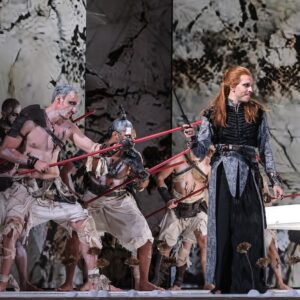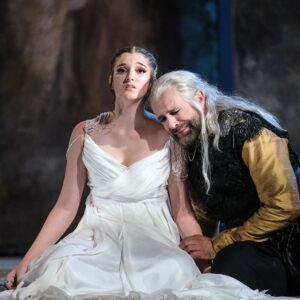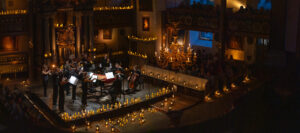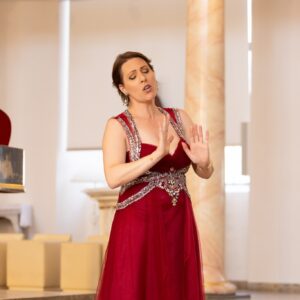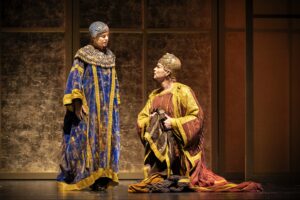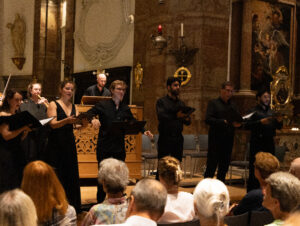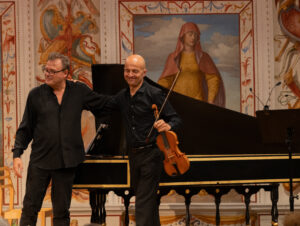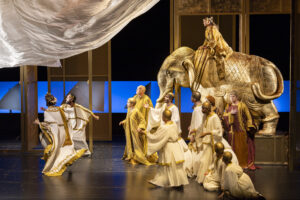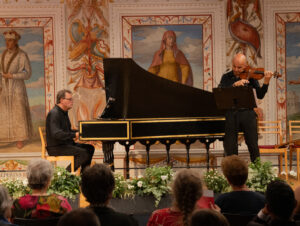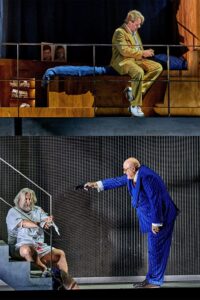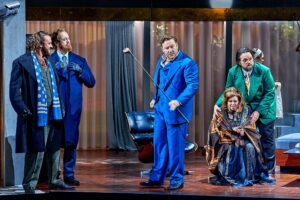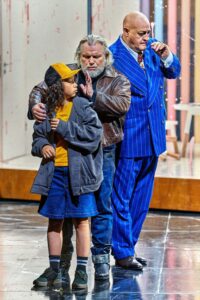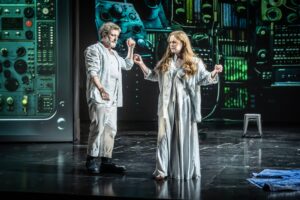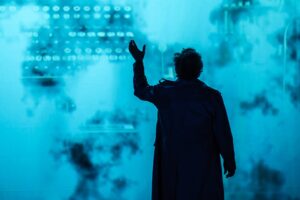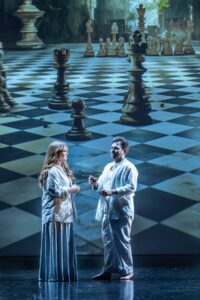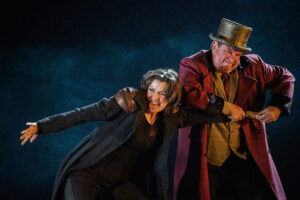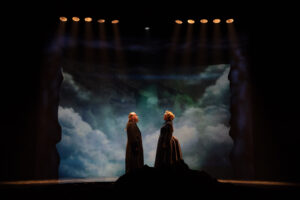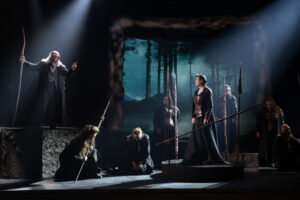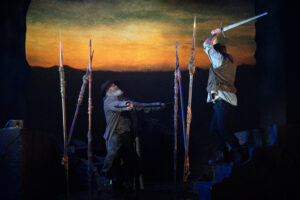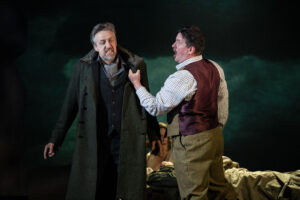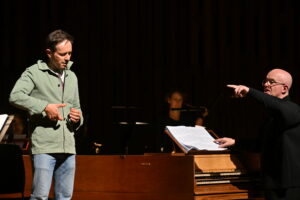Cenčić i inne żywioły
Na ogół staram się unikać cytowania wyeksploatowanych bon motów, ale w przypadku Bayreuth Baroque doprawdy nic innego nie przychodzi mi do głowy niż słynna recepta Hitchcocka na dobry film. Festiwal Maksa Emanuela Cenčicia zaczął się cztery lata temu istnym trzęsieniem ziemi i od tamtej pory napięcie nieustannie rośnie. Cenčić jest zarazem dyrektorem artystycznym imprezy oraz reżyserem i wykonawcą jednej z głównych ról w przygotowywanych rok w rok inscenizacjach zapomnianych oper barokowych – co z pozoru wydaje się idealnym przepisem na katastrofę. Tymczasem jest wręcz odwrotnie: ambitne i wizjonerskie koncepcje Cenčicia okazują się nie tylko gwoździem programu, ale też punktem wyjścia do kolejnych przedsięwzięć festiwalowych z udziałem gwiazd minionych przedstawień oraz areną coraz to nowych eksperymentów w dziedzinie wykonawstwa historycznego.
Aż strach pomyśleć, co będzie dalej. Po ubiegłorocznej premierze Händlowskiego Flavia spodziewałam się przejściowej zniżki formy. Tłumaczyłam sobie, że nie można w każdym sezonie uraczyć publiczności produkcją tak doskonałą muzycznie i przemyślaną pod względem teatralnym. Zwłaszcza że wszystkie dotychczasowe spektakle Cenčicia – prócz wielu innych zalet – odznaczały się lekkim, wręcz burleskowym poczuciem humoru, który pochopnie uznałam za najistotniejszą cechę jego warsztatu reżyserskiego. W tym roku Cenčić przypomniał nam Ifigenię w Aulidzie, jedną z najmniej znanych oper Nicoli Porpory – rzecz, mimo konwencjonalnego lieto fine, śmiertelnie poważną, eksponującą najgłębsze rozterki i dylematy moralne ludzkości, roztrząsane przez twórców od Eurypidesa, przez Racine’a, Schillera i Hauptmanna, aż po wstrząsający film Jorgosa Lantimosa Zabicie świętego jelenia.
Ifigenia w Aulidzie. Na pierwszym planie Maayan Licht (Achilles). Fot. Falk von Traubenberg
Dzieło pochodzi ze środkowego okresu twórczości kompozytora, kiedy grupka niechętnych Händlowi arystokratów, na czele z księciem Walii Fryderykiem Ludwikiem Hanowerskim, zaprosiła go do Londynu, by rzucić rękawicę wskrzeszonej kompanii Royal Academy of Music. Zespół Opera of the Nobility zainaugurował działalność w grudniu 1733 roku, premierą Arianny in Nasso Porpory w Lincoln’s Inn Fields Theatre – wyprzedzając o miesiąc szykowaną w teatrze przy Haymarket premierę Arianny in Creta Händla. Po dwóch niezbyt udanych sezonach kompania przeniosła się do King’s Theatre w Covent Garden i rozpoczęła regularną wojnę podjazdową z konkurencyjnym zespołem. Rywalizacja doprowadziła obie strony na skraj bankructwa, ostatecznie wygrał jednak Händel. Opera of the Nobility zwinęła interes w roku 1737, zrujnowana w znacznej mierze przez domagających się coraz wyższych gaż śpiewaków – między innymi kontralcistkę Francescę Bertolli, kastratów Senesina i Farinellego oraz basa Antonia Montagnanę. Zniechęcony Porpora opuścił Anglię, bezskutecznie starał się o posadę na dworze cesarskim w Wiedniu i ostatecznie wrócił do Neapolu, gdzie na pewien czas odbudował swą reputację nową, poprawioną wersją Semiramide riconosciuta.
Jeśli nie liczyć jego ostatniej londyńskiej opery, a właściwie serenaty Festa d’Imeneo, skomponowana w 1735 roku Ifigenia spotkała się z najchłodniejszym przyjęciem bywalców King’s Theatre. Zeszła z afisza po zaledwie pięciu przedstawieniach, przyćmiona przez znacznie popularniejszego Polifema. Głównym winowajcą tej porażki był zapewne stały współpracownik Porpory, librecista Paolo Antonio Rolli, który podjął niecelną wówczas decyzję, by wiernie trzymać się mitu w ujęciu Eurypidesa, i zanadto się skupił na relacjach między postaciami – kosztem efektownej dramaturgii. Pod względem muzycznym jest to bowiem dzieło niezwykłe, stawiające pod znakiem zapytania utrwalony stereotyp o „staroświeckości” stylu Porpory. Mimo dość konwencjonalnej struktury – z mnóstwem wirtuozowskich arii da capo przeplecionych z recytatywami secco – Ifigenia zachwyca liryzmem i urodą linii melodycznych, rozmaitością efektów barwowych i zapowiadającą już klasycyzm metodą konstruowania struktur harmonicznych.
Max Emanuel Cenčić, świadom, że „eurypidejskie” libretto Rolliego może paradoksalnie lepiej przemówić do wrażliwości współczesnego odbiorcy, tym razem odszedł od estetyki teatralnego pastiszu, tworząc spektakl klarowny, a zarazem nacechowany głęboką symboliką i mnóstwem odwołań do zmiennej na przestrzeni wieków, „wyobrażonej” rzeczywistości mitu. Talent scenografki Giorginy Germanou do kształtowania przestrzeni i nastroju z pomocą prostych, doskonale oświetlonych dekoracji i wyrazistych kostiumów (tym razem również jej autorstwa) chwaliłam już przy okazji pasticcia Sarrasine na tegorocznym Festiwalu Händlowskim w Getyndze. Reżyser świateł Romain de Lagarde skąpał tę scenerię w sugestywnych odcieniach czerwieni, symbolizującej krwawą ofiarę, sielankowych błękitach, bieli sugerującej niewinność Ifigenii oraz przepastnej czerni Diany/Artemidy, w mitologii greckiej bogini łowów, ale też księżyca i śmierci. Z nagością żołnierzy Agamemnona, przywodzącą na myśl sceny z klasycznych waz czerwonofigurowych, oraz barwami wojennymi Myrmidonów, okrutnych i nieokrzesanych towarzyszy Achillesa, kontrastuje złowróżbna purpura szat wieszcza Kalchasa, zawieszone poza czasem kostiumy herosów i barokowy przepych odzienia Atrydów. Najciekawszym pomysłem Cenčicia okazało się jednak rozdzielenie roli Ifigenii między młodziutką, milczącą aktorkę (Marina Diakoumakou) a towarzyszącą jej jak cień Dianę w czerni i z jelenim porożem na głowie – reżyser uwypuklił tym samym bierność tytułowej bohaterki wobec woli bóstwa, a zarazem spiął tragedię wyrazistą klamrą narracyjną: od gniewu Diany, domagającej się ludzkiej ofiary za śmierć jelenia, przez dojrzewającą w niej decyzję o uratowaniu nieszczęsnej dziewczyny, aż po nieuchronnie rodzącą się więź bogini z jej przyszła kapłanką na Taurydzie.
Ifigenia niema (Marina Diakoumakou) i Max Emanuel Cenčić (Agamemnon). Fot. Falk von Traubenberg
Wysmakowana inscenizacja tym mocniej podkreśliła niezwykłe walory interpretacji muzycznej. Kto wie, czy nie po raz pierwszy w życiu byłam świadkiem współczesnego wykonania opery barokowej, które otarło się o absolutną doskonałość. Nie będę sarkać, że w przeznaczoną dla sopranistki rolę Ulissesa wcielił się mężczyzna (Nicolò Balducci), a schedę po Farinellim w partii Achillesa przejął śpiewak dysponujący głosem mniej nośnym niż słynny kastrat z Apulii (Maayan Licht). Obydwaj soliści dowiedli, że dobrze wyszkolony kontratenor sopranowy może być prawdziwym głosem bohaterskim, swobodnie prowadzonym we wszystkich rejestrach skali, ruchliwym w koloraturach, pewnym intonacyjnie w potężnych skokach interwałowych, biegłym w stylu neapolitańskiego belcanta. Cenčić w roli Agamemnona po raz kolejny zmierzył się z legendą Senesina i znów wyszedł z tej próby zwycięsko, zarówno jako rewelacyjny technicznie śpiewak, jak i znakomity aktor. Przekonującą postać Klitemnestry stworzyła Marie-Ellen Nesi, obdarzona niezwykle ekspresyjnym, ciemnym mezzosopranem. Dźwięczny i giętki baryton Riccarda Novaro sprawił się bez zarzutu w partii Kalchasa. Bodaj największe wrażenie zrobiła jednak na mnie młodziutka Jasmin Delfs w podwójnej roli Ifigenii i Diany – nie tylko swym przepięknym, świetlistym sopranem, ale też niezwykłą swobodą i lekkością śpiewu.
Koncert przy świecach w Ordenskirche St. Georgen. Fot. Clemens Manser
Nie byłoby wszystkich tych cudów bez Christophe’a Rousseta, prowadzącego solistów i orkiestrę Les Talents Lyriques od klawesynu, z niepospolitym wyczuciem idiomu oraz bogactwa zawartych w partyturze barw, ręką pewną i zdecydowaną, na ogół w dość ostrych tempach, ale z taką dyscypliną, by nic nie zgubić z ciężaru gatunkowego tej muzyki. Nazajutrz francuski klawesynista wystąpił wraz z kilkanaściorgiem muzyków zespołu na koncercie przy świecach w Ordenskirche St. Georgen, towarzysząc znakomitej Sandrine Piau w programie zestawionym z dwóch kantat świeckich na tematy „rzymskie”, La morte di Lucretia Montéclaira i Agrippina condotta a morire Händla, oraz kantaty Domenica Scarlattiego Tinte a note di sangue, listu pisanego krwią do niewiernej kochanki – przeplecionych utworami instrumentalnymi Corellego i Alessandra Scarlattiego. Bardzo mnie wzruszył ten wieczór: pokaz najczulszej współpracy artystów z legendarną śpiewaczką, która odrobinę już zmatowiałe brzmienie swego pięknego sopranu wynagrodziła z nawiązką fenomenalną techniką i niebywałą dojrzałością interpretacji.
Lucile Richardot. Fot. Clemens Manser
Szkoda, że tej mądrości zabrakło Lucile Richardot, która dzień wcześniej zaprezentowała w Schlosskirche atrakcyjny program złożony z arii „barokowych czarodziejek” – Medei, Armidy i Kirke – z bardzo sprawnym Jean-Lukiem Ho przy klawesynie. Jej niezwykły, nieomal tenorowy w brzmieniu kontralt wciąż lśni głębokim blaskiem. Jej interpretacje robią się coraz bardziej manieryczne – ze szkodą zarówno dla głosu, jak i samej muzyki. Niewykluczone jednak, że oceniam Richardot zbyt surowo, wciąż nie mogąc się otrząsnąć z zachwytu po dwóch wieczorach, które przeniosły mnie w całkiem inny wymiar historycznego wykonawstwa.
Na Bayreuth Baroque wpadłam w tym roku jak po ogień – żeby doświadczyć trzęsienia ziemi i serii wstrząsów wtórnych. W przyszłych sezonach oczekuję tsunami, osuwisk i muzycznych pożarów. W sztuce budowania napięcia Cenčić zdołał już prześcignąć samego Hitchcocka.

